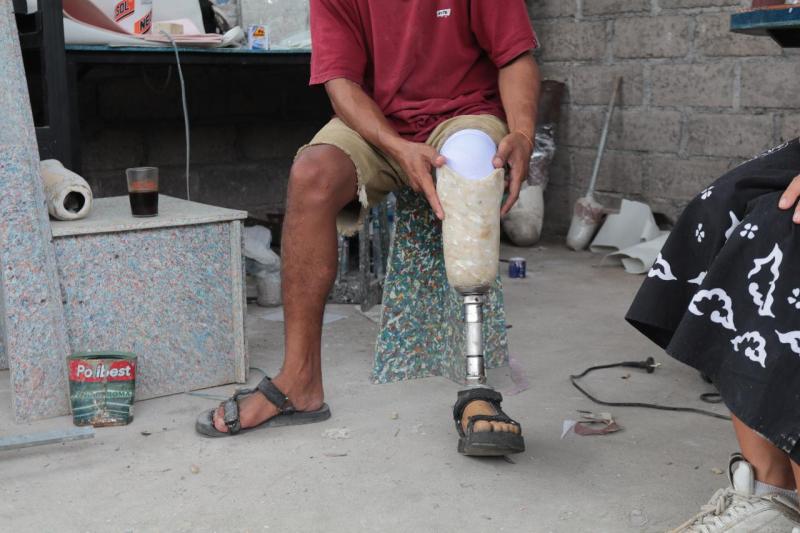Plastic waste is a major problem, but what if you could turn the world’s trash into treasure? [Yayasan Kaki Kita Sukasada (YKKS)] in Indonesia is doing this by using recycled plastic to make prosthetic legs.
Polypropylene source material is shredded and formed into a sheet which is molded into the required shape for the socket. A layer of cloth and foam is used to cushion the interface between the patient and the socket itself. Using waste plastic to make parts for the prosthetics lowers the price for patients as well as helps to keep this material out of the landfill.
What makes this project really exciting is that [YKKS] employs disabled people who develop the prosthetics and also trains patients on how to maintain and repair their prosthetics with easily sourced tools and materials. With some medical device companies abandoning their devices, this is certainly a welcome difference.
We’ve previously covered the Precious Plastic machines used to make the plastic sheets and the organization’s developments at small scale injection molding.
















While it’s better than nothing, for applications like this I have some doubts on the safety of recycling just any plastic. Lots of plastics contain not insignificant amounts of additive chemicals (plasticizers, stabilizers, colorants, etc. This is also one of the obstacles to re-use of plastics in recycling. Even if the base material is known, the additives can make or break certain applications) Most of those are fine for intermittent contact but who knows how they behave and interact with the body with prolonged contact with the body in this use?
Per the article, There’s a layer of cloth against the skin.
I’d still be concerned about the potential for structural failures of unknown plastic mixes? But still better than nothing.
Which is why their goal is not just to provide a prosthetic, but also 1) make it cheap and 2) make it easily maintainable by the owner (including teaching them how to conduct said maintenance), as mentioned in the video. So if something goes pear shape, the owner should be able to repair their prosthetic themselves readily and economically.
Also in the video, and regarding chemicals migration, we can see that between the recycled plastic socket and body, there is at least 2 layers of clothe + the foam insert. So I suppose that even if the 2 layers of clothes were not sufficient, the health hazard would be with the foam and not the recycled plastic socket.
Amputee here (leg). The wearer’s limb doesn’t come in contact with the socket. There is a liner (made of silicone with a nylon outer layer) that goes between the socket and wearer. Although I would be worried about the sturdiness of a plastic socket (mine is carbon fiber), it sure beats not being able to afford a traditional prosthetic.
CF is great for being light and strong – these look to be 20mm thick – it is well into overkill strength territory if they did a good job creating it from the recycled scrap, and even a bad job should still be rather overkill.
Even better being a relatively elastic plastic IF you ever managed to put too much load on it it would stretch and feel odd to the user, giving time to deal with the issue. Where as CF fails brittle – so if you do ever manage to load it too much its just going to shatter with no warning.
CF would still be IMO the better choice – all that extra weight these plastic ones have must be rather exhausting, but if you can only get plastic not going to say no and thus hop everywhere…
Chalk it up to morning, but I read the headline as “precarious plastic prosthetics”
Yayasan Kaki Kita Sukasada (YKKS) in Bahasa Indonesia translates to Our Feet Foundation of Sukasada. I believe Sukasada is a district (kecamatan) in the regency of Buleleng in northern Bali Island, Indonesia.[1] Kecamatan Sukasada is home to some beautiful waterfalls, including Aling-Aling falls.[2]
* References:
1. Kecamatan Sukasada, Buleleng Regency, Bali, Indonesia
https://www.google.com/maps/place/Sukasada,+Buleleng+Regency,+Bali,+Indonesia/@-8.2248138,115.0361889,12.17z
2. Aling Aling – 7 Waterfalls of Sambangans Secret Garden
https://balibuddies.com/aling-aling-waterfall/
Given that the start of this process is shredding th plastic
and
the each plastic has a different density
Is there a method, cheap, low tech etc that could be used to separate the plastic into type?
We should be trying to help this guy